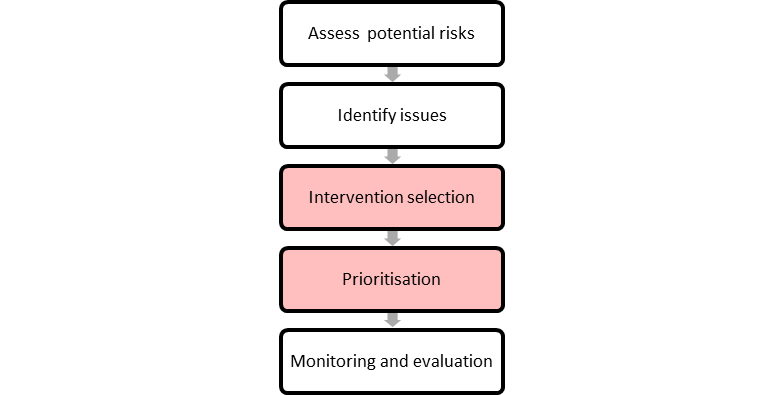
Road Safety Manual
A manual for practitioners and decision makers
on implementing safe system infrastructure!

Road Safety Manual
A manual for practitioners and decision makers
on implementing safe system infrastructure!
Once risk locations have been identified, and relevant information analysed to identify the likely causes, there is a need to select interventions and prioritise these for action. Figure 11.1 shows how this fits within the risk assessment process for managing infrastructure safety.

There is a cost associated with every road safety infrastructure intervention. Every country has a limited budget available with which to make road safety improvements, and so it is important to ensure that reductions in deaths and serious injuries are maximised within the budget available. This requires good knowledge about the effectiveness of road safety interventions in different circumstances. It also requires a process to help prioritise the installation of safety treatments. Interventions are the individual and collective actions that are taken to address risk. The terms ‘countermeasures’ or ‘treatments’ are also used.
This chapter provides information on the selection and prioritisation of effective road safety engineering interventions. It provides advice on the types of options that are available, and the process and tools that can be used to decide upon the most appropriate options. Intervention options and selection are outlined in Intervention Option and Selection. In order to maximise safety outcomes, a priority ranking method is required, and this is typically based on economic assessment. This process is described in Priority Ranking Methods and Economic Assessments
Several guidelines exist on some of the key crash types that contribute most to death and serious injury. Some of these are aimed at addressing problems in LMICs, and provide information on effective interventions. These include:
Other documents exist that provide more general advice for these and other key crash types (i.e. they are not specifically targeted at the issues in LMICs). Some of these documents are freely accessible and provide guidance on the following issues.
Run-off-road interventions:
Intersection crashes:
Head-on crashes:
Many other documents can be accessed via the Internet from a variety of sources on these and other crash types. However, care should be taken to ensure that documents accessed from this source have been produced by reputable agencies, and that they provide robust information. Other documents exist that provide advice on a range of crash types and appropriate interventions in an easy to access format. Key documents are listed later in this chapter.
The most cost-effective interventions to target key crash problems are well known. As a starting point, these interventions should be implemented in a targeted way on high risk routes. These include:
An ideal starting point is to implement multi-sector (e.g. including policing and education programmes) demonstration projects on key high-risk corridors utilising these effective interventions. For those just starting this is a useful way to ‘learn by doing’ in a way that is easy to manage.
Economic assessment procedures need to be established, and key staff trained in this process. This will help effectively prioritise limited budgets. It will also help prepare an adequate business case for investing in road safety.